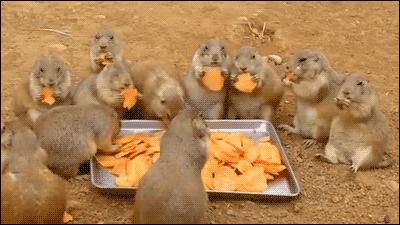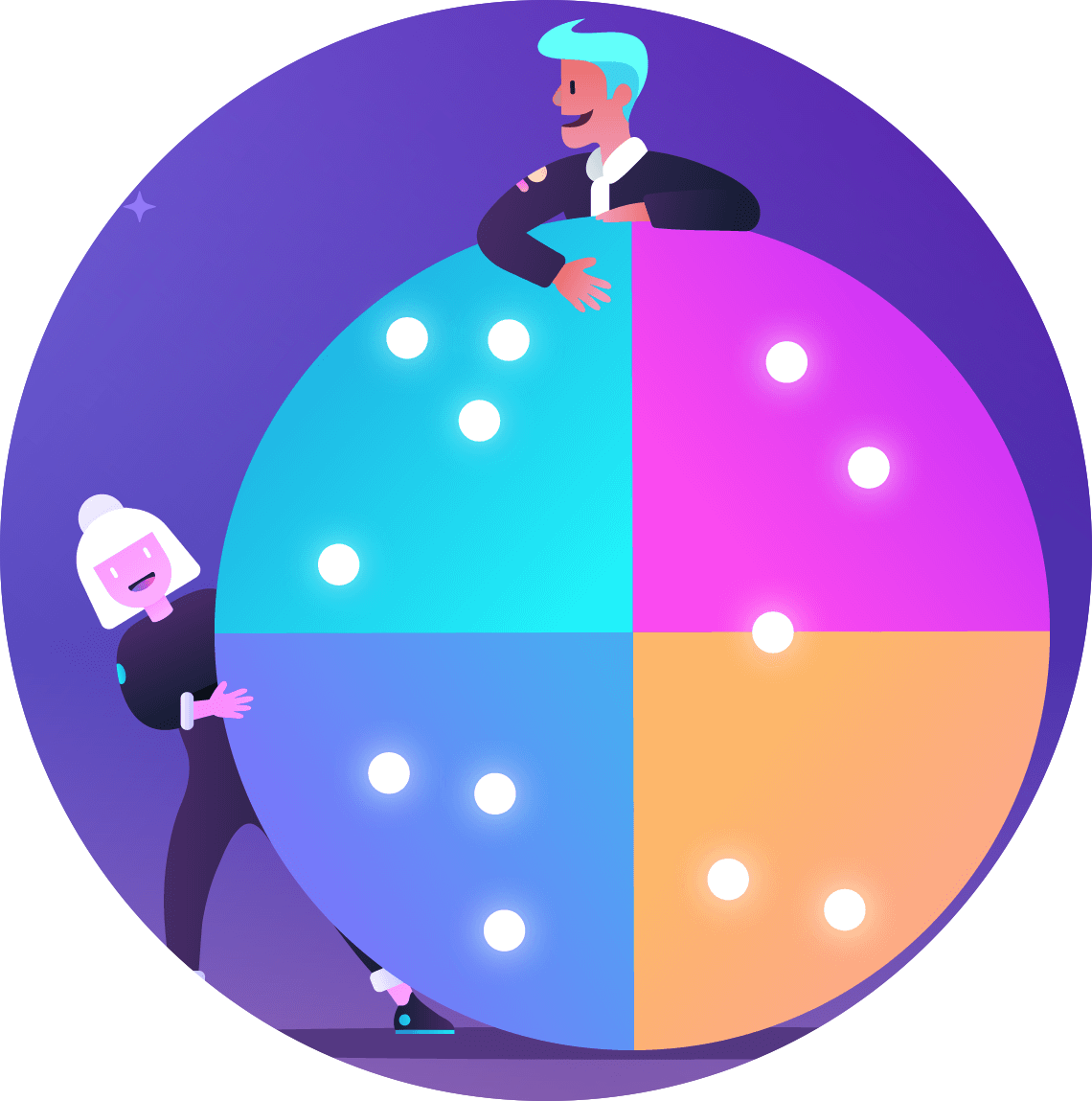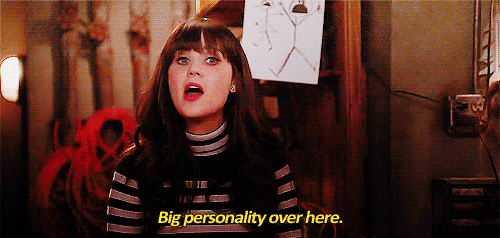ENFJ, INFP, ISFP, ENTJ… Unless you’ve got your MBTI on your Twitter profile, you might not be overly familiar with these code names. What about iD, DC, or Si? No, they’re not elements on the periodic table—all of these acronyms are actually personality test results.
Using personality tests at work can be controversial and polarizing, even while being wildly popular.
Some 89% of the Fortune 100 use the Myers-Briggs Type Indicator (MBTI) test for either hiring or professional development, even while much research questions the test’s liability and inability to be scientifically consistent. Indeed, there are risks involved anytime people attempt to label or categorize others based on standardized traits or—worse—stereotypes.
But what if personality tests have just been used for the wrong reasons in the workplace?
Rather than putting people into pre-categorized boxes (and keeping them there), they can spark candid conversations and create all-too-important awareness around one very important fact—that not everyone works or thinks the same way.
Recently, my team collectively took a personality test as a team-building exercise. After getting our results, we spent half a day together to go over the results and really dig into what about what our team’s “types” meant for how we worked well (or not so well) together.
We discovered some really spicy things:
- Misconceptions we had about certain people
- The risks of groupthink we were under
- How much each of us loved (or hated) certain aspects of how we collaborated on a daily basis.
Controversy or no, we walked away feeling closer and more capable at collaborating with each other. Here’s what we learned from getting started to running a successful personality assessment workshop.
Putting Our Team’s Personalities On The Table
We’re a remote team so, at a recent offsite, we set aside a half day to go through a facilitated teamwork workshop built around the personality test.
Hiring a professional was extremely helpful. Having an independent third-party to administer and interpret the results based on our goal to learn more about each other as a team helped us make the time productive and valuable.
We took the test in advance, and arrived to the workshop with a printout of our profiles, top traits, and behavioral inclinations.

With four hours of training ahead of us, we also brought a lot of snacks.
We chose the DiSC® assessment published by Wiley, which is described by one distributor as “a non-judgmental tool used for discussion of people’s behavioral differences.” Based on a series of questions around behaviors and emotions that relate to collaboration and workstyles, we were individually plotted onto a circular grid with four sections of “common” personality types:
- Dominance: An active and questioning style. D’s are unafraid to express their opinions, which can be perceived as direct and strong.
- Influence: An active and accepting style. I’s are idealistic and outgoing, which can be perceived as lively or enthusiastic.
- Steadiness: A thoughtful and accepting style. S’s are patient and supportive of others, which can be perceived as supportive and accommodating.
- Conscientiousness: A thoughtful, questioning style. C’s are precise and analytical, appearing reserved while taking time to consider all facets of an issue.

With each person’s profile represented as a dot placed in related to the “D”, “i”, “S”, and “C” poles, it essentially created a personality map of our team. Some dots were closer together, even categorized as iD or CS, while others, such as D and S are opposed as based on the circular grid structure.
But we didn’t know the results right away!
Instead, the facilitator taped a piece of paper with each letter on the wall at each corner of the room. She then asked that we stand up and head to our corner, whether it was D, i, S, or C. As the clusters began to form around these attributes, the discussion we were about to have about our team dynamics took shape.
Experiencing this categorization in physical form made a few things very apparent:
- More than half our team was categorized as the same “type.”
- We had certain people directly opposing others (D’s and S’s, I’s and C’s).
- Some of the placements made sense, based on our understanding of people’s personalities in general, but some were very surprising!
Any preconceived notions we might have had about people’s outward behavior and their personal tendencies were about to be put up for discussion.
The Trials And Triumphs Of A Personality Test
The best chance for success when choosing to have your team take a shared personality test is to reflect on the why for getting assessed.
In bringing this exercise to our offsite, our goal was to build a shared understanding of the spectrum of our team’s approaches to work before we kicked off our next fiscal year’s worth of project planning.
Understanding differences creates empathy, which builds emotional intelligence, which contributes to productivity, happiness, and retention among teams.
In addition to fostering an empathetic culture, you might want to improve specific aspects of your teamwork, boost communication with a shared language, or explore team fit for each member so everyone is (hopefully) happier with their work.
Here’s where even skeptics can get on board: You don’t need to agree with the test results in order to find value in the exercise itself.
As Leah Fessler writes in the Quartz piece, “Managers are missing out on the most important part of personality tests,”:
Reflecting together on the accuracies and inconsistencies we perceived between our test results and our own self-image revealed our insecurities about our jobs, insights about which communication tactics we liked and disliked, and our professional strengths—all of this before we knew one another’s neighborhoods, alma maters, or relationship statuses. […]
But the information gleaned in these discussions offered a different kind of intelligence on the people in our work environment, intelligence that’s typically tough to gain otherwise.
Rather than simply focusing on the specific traits assigned to each individual, you can form high-level questions about the patterns or problems in the results:
- Do your team members feel their results accurately represent them? Why or why not?
- Do the results speak to assumptions made about people on the team? Are they accurate?
- Do you have many similar personality types with a few outliers?
- Are there opposing profiles that can better leverage each other’s strengths and weaknesses?
These were all healthy debates that were sparked at our offsite.

In order to make sure this is a valuable team exercise, lay out some ground rules to avoid the risks that personality test critics often point out. You want to resist creating stereotypes or putting people into boxes that limit them to certain roles or opportunities within the team.
Our team set out to challenge the stereotypes at the outset.
For example, our facilitator provided examples of successful business professionals and leaders that have been categorized as all different types of DiSC and MBTI. It’s key to emphasize there is no one “best type” of person for a role—no, extroverts don’t always make the best leaders!
In the same Quartz article, Fessler also quotes Jean Graves, CEO of coaching firm TalentSmart, who asserts that the value of the test should be communicated clearly with your team:
“Understanding that no personality test result is good or bad, right or wrong, this conversation should be driven by one question only, says Greaves: How can we put these new insights into practice so as to achieve your goals?”
Building The Team Personality Puzzle Together

Not all personality tests are created equal.
Some are distinctly made for hiring processes, while others are instead geared for team development—some of which focus on helping employees discover their strengths or explore career paths, while others highlight communication and collaboration styles.
The whole point of team development-focused tests is to build emotional intelligence between its members. In other words, it’s to remind each other that we’re all human beings with different perspectives, experiences, and skills—because that understanding helps teams perform better.
According to this detailed analysis from EQ experts Dr. Vanessa Druskat and Dr. Steven Wolff:
“Our research tells us that three conditions are essential to a group’s effectiveness: trust among members, a sense of group identity, and a sense of group efficacy.”
Personality tests provide a common language to frame identity and built trust through communication. For our team, exploring our tendencies and preferences through the lens of being a “D” (straightforward, results-oriented, quick to action) versus an “S” (considerate, team-oriented, measure twice) helped frame conflict into theoretical terms that we all understood. From there, we could talk about strategies to try and next steps that took everyone’s viewpoint into account.
Here are some resources to help you start exploring the right fit for your team:
- Workstyle: Workstyle helps put together customized personality tests for your team and breaks down the top tests in this listicle blog post.
- Business ChemistryⓇ: Deloitte worked with neuroscientists to produce this approach to understanding work styles and communication in business relationships.
- HRDQ Style Series: HRDQ offers team training resources and breaks down personality tests into different categories like communication styles and leadership styles.
- Everything DiSCⓇ: The official source for the DiSC assessment, including some great resources and research.
- MBTI: The official Myers-Briggs Type Indicator test, including some trend reports and case studies to see how other teams have used it.
- 16Personalities: A free version of the MBTI, it can be a great starting point for giving the test process a try.
- Via Institute on Character: This free test helps highlight key strengths like “love of learning” or “analytic skills” instead of overall personality strengths if you’d like to really keep things in your team test exercise positive and upbeat.
It’s worth doing your research with a critical eye and an open mind.
Merve Emre is the author of The Personality Brokers: The Strange History of Myers-Briggs and the Birth of Personality Testing, and went into her research which a critical eye to the dangers of testing in the workplace. However, her findings led to a more nuanced reality writes the New York Times:
“[W]hat she once derided as a mass-produced tool of social control also, she realized, offered people a chance to understand themselves and one another.”
As it happened for our team, we entered the room with a score, we left with a deeper understanding of each other.
Whatever your position on the validity of these tests, our experience certainly helped us learn how to relate to each other with more care—what started as a test became a surprisingly powerful chance for our team to connect on a more human level.
Good or bad, we’d love to hear your thoughts. Find us on Twitter (@trello) or write in to support@trello.com





 )
) 




































